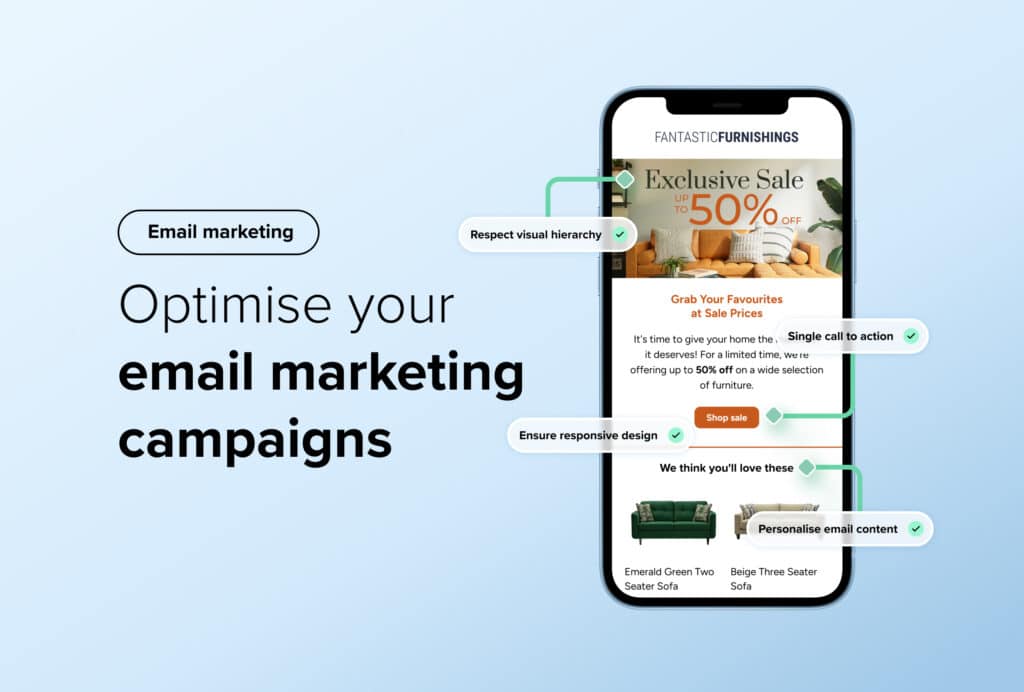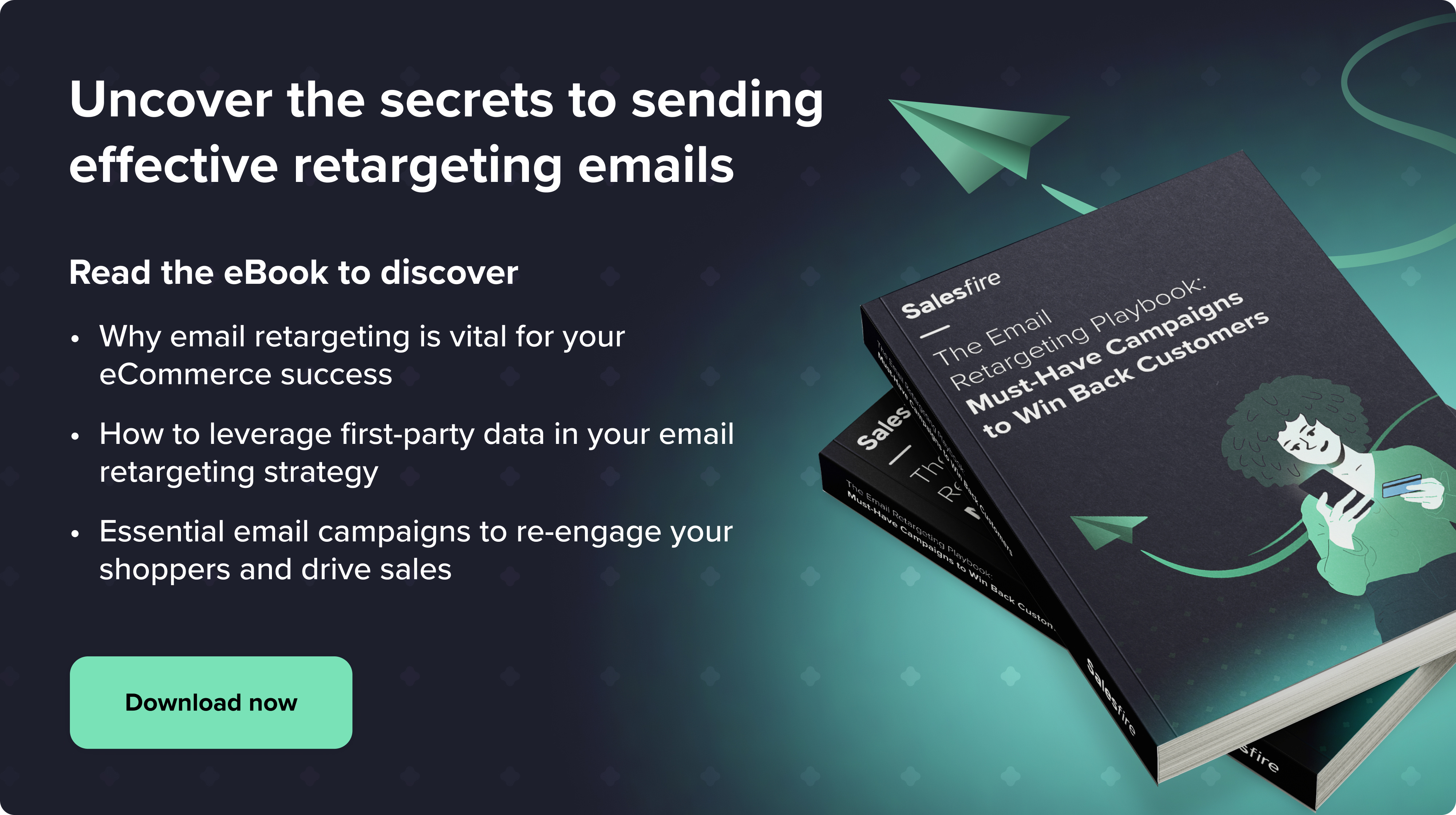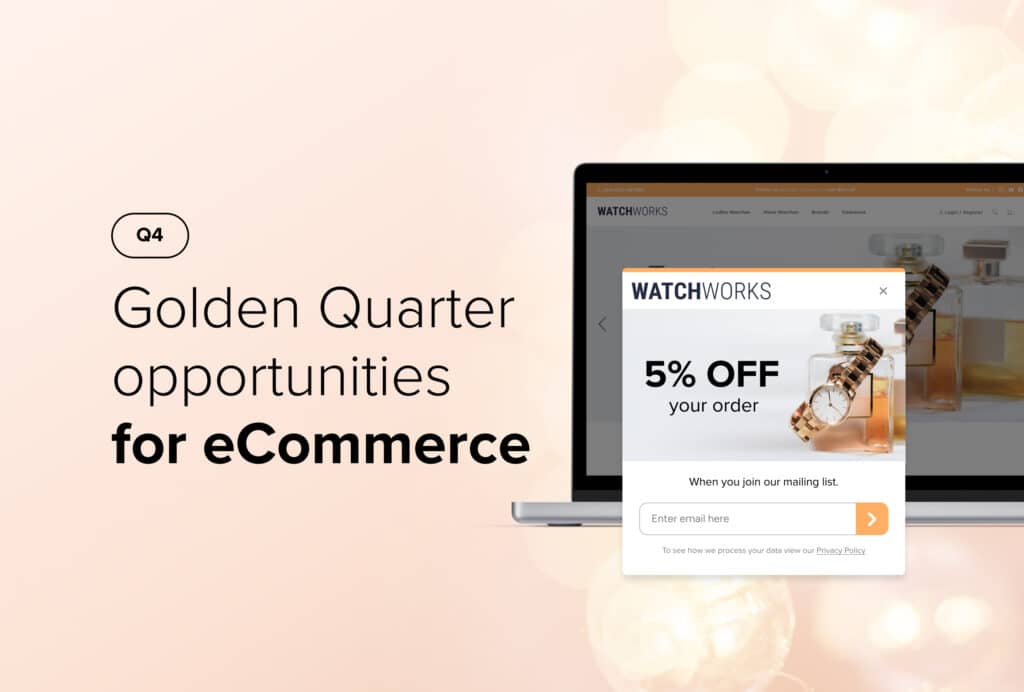
Email is one of the most important marketing channels for eCommerce retailers, and following email marketing best practices is essential for sending successful campaigns.
Rather than being at the mercy of confusing algorithms, email marketing gives your brand greater control over who sees your content, what they see, and when they see it.
Our research has shown that, on average, a shopper may visit your website up to nine times before they make a purchase. Email marketing is an essential tool you can use to keep these users engaged and move them closer to a conversion.
To help you send emails that effectively drive shoppers back to your site, we’ve put together this easy-to-follow guide of email marketing best practices.

What are the advantages of following best practices for email marketing?
Although email marketing is not dictated by algorithms in the same way as social media, there are still rules your brand must follow if you want your message to be seen and interacted with.
Following best practices for the content, design, and sending of your email campaigns can:
- Boost engagement: Aligning your subject lines and overall email marketing strategy with best practices can boost open rates and make shoppers more likely to read your emails.
- Increase conversion rates: Emails with effective content and design can drive more shoppers to click through to your site and purchase.
- Improve your ROI: Following established email marketing guidelines can improve the effectiveness of your campaigns. This can drive sales whilst preventing you from wasting your budget on sending ineffective emails, boosting your ROI.
- Maintain your brand reputation: Consumer concerns around data privacy are increasing, and regulations are constantly changing. Following best practices ensures your brand’s emails will be viewed favourably by consumers and the law.
- Avoid spam filters: Sticking to best practices can prevent you from making mistakes in your email campaigns that can trigger the spam filters of email servers, such as including too many images.
Best practices for sending email marketing campaigns
Before getting into email content and design, it’s crucial to master the foundations of email marketing. Carefully identifying who you’re sending to and when should form the basis of your strategy and will help to drive email deliverability, ensuring that the marketing emails you send land in your shoppers’ main inboxes.
Email providers often use engagement as a factor in ranking email importance. With Gmail, Outlook, and now Apple Mail all using folder categorisation to help users prioritise their emails, it’s more important than ever that users are interacting with your content. Otherwise, your emails may end up in a secondary inbox, never to be seen at all.1
There are several marketing email best practices you can implement to help boost email deliverability and engagement rates.
Build a strong mailing list
Sending marketing emails to a shopper requires access to their email address. To extend the reach of your email marketing campaigns, you should strengthen your mailing list by maximising the data you capture from your shoppers on-site.
Data capture technologies such as Salesfire can ethically boost shopper data collection. Using intelligent data capture campaigns, these technologies can significantly grow your mailing lists, enabling you to deliver email campaigns to more of your shoppers.
Additional reading: How to Grow Your Email List
Respect privacy laws
When processing shopper data such as email addresses, there are specific legal regulations your brand must adhere to.
If handling data from UK and EU contacts, this includes the General Data Protection Regulation (GDPR). When dealing with data belonging to US residents, you must adhere to the Controlling the Assault of Non-Solicited Pornography and Marketing Act (CAN-SPAM).
To align with the legal requirements of both of these regulations and avoid expensive fines, it’s generally best practice in email marketing to:
- Gain explicit marketing consent before sending an email to a contact
- Avoid sending contacts misleading or inappropriate email content
- Provide an easy way for contacts to unsubscribe
- Remove the data of anyone who requests it in a timely manner
Use a subdomain
An email domain is the part of an email address after the @ symbol.
Using a branded domain, for example ‘@salesfire.com’, can help your emails appear more professional and trustworthy to your audience.
However, if your root domain, in this case ‘@salesfire.com’ is marked as spam, this is difficult to reverse and can have a long-term impact on your email deliverability.
Instead, you should use a subdomain such as ‘@email.salesfire.com’. If your subdomain receives a negative reputation, you can easily scrap it and start sending again with a new one such as ‘@send.salesfire.com’ without impacting your root domain.
Segment your audience
Sending blanket email campaigns to your entire mailing list is likely to result in recipients being uninterested in your content, ignoring it, and even unsubscribing.
Deliver campaigns your audience will find interesting by segmenting shoppers into smaller groups. You could segment shoppers based on:
- Purchase history: Consider your shoppers’ past shopping behaviour and adjust the emails you send accordingly. For example, send shoppers who typically buy reduced items an email about your new sale.
- Demographics: Create audience segments using shopper birthdays, gender or location so that they receive appropriate messaging.
- Interests: Group shoppers based on the brands or product types they have been viewing or searching for, and send them content related to similar products.
Personalise your campaigns
Engage shoppers with content personalised to their on-site activity, such as emails relating to products they’ve viewed or searched for. With an email retargeting tool like Salesfire, you could even automatically trigger email campaigns based on real-time behaviours, like letting a shopper know that a product they have been viewing is back in stock.
Personalised emails have a 26% higher open rate than generic emails, meaning personalisation could significantly boost your email engagement.2
Further reading: How SMEs Can Achieve Personalisation at Scale
Deliver your message at the right time
Sending marketing emails too often or sending them at the wrong time can result in your engagement rates taking a hit.
You’ll want to develop a balance between sending too little so that your shoppers forget about you and sending so often that they get frustrated and are driven to unsubscribe. Doing this will prevent you from overwhelming or fatiguing your audience with your messaging.
The optimal time to send an email will vary depending on who your shoppers are. If you are a B2C company, your audience will likely be viewing their emails either before work, on their lunch break, or after work. However, if you’re a B2B company, sending during work hours is your best bet.
Email marketing benchmarks, including the most effective times and frequency to send emails, can differ for every industry. Make sure to carry out frequent experiments so that you can test what works for your specific audience.
Best practices for email content
Now that you’ve got the basics in place, you can move on to optimising your campaigns further by applying email content best practices.
Email content is everything you include in the email itself, from subject lines to images to call-to-actions (CTAs).
Effective email marketing content should encourage shoppers to open the email, make it easy to understand the message, and drive clicks to your website.
Here are our top email marketing tips for creating content that drives clicks and conversions.
1. Write compelling copy
Your shoppers may receive tens or even hundreds of marketing emails every day, meaning there are many opportunities for distraction. Every word you include in your emails, whether in the subject line or the email itself, needs to grab and hold the attention of the recipient.
Choose a snappy subject line
The subject line of your email is the very first thing the user will see, so this needs to stand out. Here are our top tips:
- Keep it short but sweet: Subject lines should be kept to under 90 characters so you need to get your point across in as few words as possible. If you’ve got something to offer your shoppers, make sure you let them know within the subject line to inspire opens.
- Include an emoji: Emojis can make your email stand out and draw the recipient’s eye to your email in their inbox.
- Don’t come across as spam: Avoid overusing emojis, punctuation or capital letters as this can trigger spam filters, and your email can be sent to junk.
Refine your tone of voice
The body copy of your email should reflect your brand’s tone of voice. As your shoppers are likely already familiar with this voice, it helps to generate a feeling of trustworthiness towards your emails.
However, different types of email communications will benefit from a slight adjustment in tone of voice. For example:
- Transactional emails: These should be clear and professional, containing only essential information that is required by the shopper.
- Newsletters: Often used to provide casual business or product updates, a newsletter could take on a more conversational and friendly tone of voice.
- Promotional emails: These emails can be a chance to go bolder and shout about what makes your brand great.
2. Focus on a single message
When promoting your brand through email, you may feel like you need to make the most of the space available by including as much information as possible. However, less is often more in this context.
If you include too many messages, shoppers could get confused and zone out. An email that’s clear and easy to process is much more likely to drive action as the recipient can understand exactly what you want them to do next.
In each email you send, your content should revolve around a single call to action. This could be things like encouraging the recipient to shop your new sale items or complete an unfinished purchase.
Directing the shopper to carry out more than one action could dilute your message, making it less effective at achieving your objective.
3. Optimise email for readability
You should structure your email in a way that makes your message as easy to digest for the shopper as possible. By reducing the effort required to read the email, shoppers are more likely to process and act on your content.
Follow a logical structure
Include the most important information ‘above the fold’ at the top of the email. This should be displayed using a simple format, allowing for quick reading so that even if the shopper doesn’t read the rest of the email, they understand the message.
Add any secondary messages, such as information that is more detailed or less important but ‘nice to have’, further down the email. This allows the shopper to read it if they’d like without distracting from the main offer or message.
Simplify your content
An email consisting of large blocks of text can be off-putting for the many shoppers who have limited time to read your emails or those viewing them on the go.
It’s best to keep sentences simple, separate text into shorter paragraphs, and pull out key points into lists or bullet points that can be quickly scanned. Using headers also allows shoppers to easily navigate to the specific information they are interested in.
Applying these techniques can greatly improve engagement rates by gently guiding shoppers through your email content.
Email design best practices
Viewing an email is an experience.
After you’ve invested time in optimising your audience segments, send times, and subject lines and the shopper has opened your email, the first thing they will notice is how it looks.
Your email design needs to immediately catch the shopper’s eye and lead them through the content, otherwise, they may click off the email without reading it at all, and your message will go unheard.
To assist you with your email aesthetics, we’ve pulled together our top tips for email design optimisation.
1. Keep it clean
Don’t underestimate the importance of including white space in your email design.
Giving text, buttons, and images within your email some breathing space stops your content from appearing overly busy and cramped.
While colours, bold text, images, and contrasting CTA buttons can help to divide up the email into bite-sized sections, you should avoid overwhelming your shoppers by cramming too many of these in a single campaign.
By making your emails easier on the eye, shoppers will be more inclined to spend time reading them, and your CTAs will be easier to find, which can drive conversions.
2. Avoid image overload
Using too many images within your email could accidentally trigger spam filters and result in your email being hidden.
It’s considered best practice for marketing emails to consist of 60% images and 40% text. Not only does this allow you to create eye-catching visuals without being marked as spam, but it also helps with accessibility, as a fully image-based email excludes visually impaired shoppers who use screen readers.
3. Respect visual hierarchy
Formatting your email design in a way that respects the shopper’s existing expectations is essential.
Text that is large, bold, or placed higher in your email will be viewed as the most important, so anything you need your shoppers to read should be placed here.
Structuring your email design in this way means that even if shoppers quickly scan over the email or don’t scroll down, they can still take away the key message.
4. Make it mobile-friendly
Over half of all emails are opened using a mobile device.3
To promote conversions from this majority audience, mobile-responsive email design needs to be at the forefront of your mind when creating your campaigns.
Within your email provider, you should be able to build dynamic emails that adapt your content to changing screen sizes. It’s best to set your content to collapse into a single column on mobile to prevent multiple columns from appearing cluttered or misaligned.
Finally, you should ensure that text and images are large enough to still be readable on a smaller screen. The current guidance suggests using a font size of 14px minimum.
5. Test, test, test!
How your campaign looks within your email builder may not be how it looks in a shopper’s inbox. Different email providers, devices, and dark mode can skew how your email displays.
That’s why it’s always best to utilise the test or preview feature offered by most email providers to check exactly how your email is going to appear. This can help you avoid any nasty surprises that could negatively impact your brand’s reputation.
Email Marketing Do’s and Don’ts
To help simplify the process of email marketing optimisation, we’ve created a quickfire list of dos and don’ts for you to refer to.
Do:
- Segment and personalise: Divide your audience into smaller groups based on their demographics, purchase history and interests. This allows you to send more targeted and personalised emails, which can boost engagement.
- Test and optimise: Experiment with different campaign types, send times, or frequency and monitor their effectiveness by measuring metrics like open rate, click-through rate and conversions. Use this data to improve your future email sends.
- Prioritise user experience: Put yourself in the shoes of your shoppers. Consider how they view and read emails and adapt your content to their needs. Ensure your emails follow a logical structure that is easy to follow.
Don’t:
- Overwhelm your audience: Don’t send emails so often that shoppers get frustrated and are driven to unsubscribe. Ensure emails aren’t too busy and cramped by incorporating white space and limiting images, buttons, and large blocks of text.
- Neglect mobile optimisation: Use dynamic email templates that adapt to the recipient’s device. Include images and text that are large enough to be readable on a small screen.
- Mislead or confuse: Avoid using subject lines that don’t align with the email content. Focus on a single call to action throughout each email you send to keep your message clear.
Before sending an email campaign, check it against these dos and don’ts to see if you could improve its effectiveness.
Sending successful email marketing
Most retailers are sending some form of email marketing, but not all of them are doing it successfully.
There are certain steps you need to follow to send marketing emails that effectively engage your shoppers and drive them back to your site to purchase. We’ve discussed guidelines for sending email marketing, refining their content, and email campaign design best practices.
To avoid ending up in the user’s spam folder, you must take care to comply with legal regulations. However, one of the most important practices when sending marketing emails is to always put the needs of the shopper first.
Deploying targeted emails with highly personalised content and easy-to-follow designs can make it more likely that a shopper will convert as a result.

1 How to choose the best Gmail inbox type for your needs | Google
2 An Expert Guide to Email Personalization [2024] | American Marketing Association
Sending best-practice marketing emails is effortless with Salesfire. Book a demo today to start using these tips in your next campaign.



